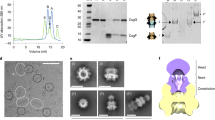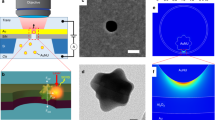Abstract
Double electron-electron resonance (DEER) is an electron paramagnetic resonance (EPR) technique used to determine distance distributions in the nanometer range between spin labels by measuring their dipole-dipole interactions. Here we describe how in-cell DEER can be applied to spin-labeled DNA sequences to unravel their conformations in living cells by long-range distance measurements in cellula. As EPR detects unpaired electron spins only, diamagnetic molecules provide no background and do not reduce detection sensitivity of the specific signal. Compared with in-cell NMR spectroscopy, low concentrations of spin-labeled molecules can be used owing to the higher sensitivity of EPR per spin. This protocol describes the synthesis of the spin labels, their introduction in DNA strands, the injection of labeled DNA solutions in cells and the performance of in-cell EPR measurements. Completion of the entire protocol takes ∼20 d.
This is a preview of subscription content, access via your institution
Access options
Subscribe to this journal
Receive 12 print issues and online access
$259.00 per year
only $21.58 per issue
Buy this article
- Purchase on Springer Link
- Instant access to full article PDF
Prices may be subject to local taxes which are calculated during checkout







Similar content being viewed by others
References
Pannier, M., Veit, S., Godt, A., Jeschke, G. & Spiess, H.W. Dead-time free measurement of dipole-dipole interactions between electron spins. J. Magn. Reson. 142, 331–340 (2000).
Schiemann, O. et al. Spin labeling of oligonucleotides with the nitroxide TPA and use of PELDOR, a pulse EPR method, to measure intramolecular distances. Nat. Protoc. 2, 904–923 (2007).
Banham, J.E. et al. Distance measurements in the borderline region of applicability of cw EPR and DEER: a model study on a homologous series of spin-labelled peptides. J. Magn. Reson. 191, 202–218 (2007).
Pielak, G.J. & Tian, F. Membrane proteins, magic-angle spinning, and in-cell NMR. Proc. Natl Acad. Sci. USA 109, 4715–4716 (2012).
Serber, Z. et al. Investigating macromolecules inside cultured and injected cells by in-cell NMR spectroscopy. Nat. Protoc. 1, 2701–2709 (2006).
Igarashi, R. et al. Distance determination in proteins inside Xenopus laevis oocytes by double electron-electron resonance experiments. J. Am. Chem. Soc. 132, 8228–8229 (2010).
Azarkh, M. et al. Long-range distance determination in a DNA model system inside Xenopus laevis oocytes by in-cell spin-label EPR. ChemBioChem 12, 1992–1995 (2011).
Krstic, I. et al. Long-range distance measurements on nucleic acids in cells by pulsed EPR spectroscopy. Angew. Chem. Int. Ed. 50, 5070–5074 (2011).
Singh, V., Azarkh, M., Exner, T.E., Hartig, J.S. & Drescher, M. Human telomeric quadruplex conformations studied by pulsed EPR. Angew. Chem. Int. Ed. 48, 9728–9730 (2009).
Hänsel, R. et al. The parallel G-quadruplex structure of vertebrate telomeric repeat sequences is not the preferred folding topology under physiological conditions. Nucleic Acids Res. 39, 5768–5775 (2011).
Hänsel, R. et al. Evaluation of parameters critical for observing nucleic acids inside living Xenopus laevis oocytes by in-cell NMR spectroscopy. J. Am. Chem. Soc. 131, 15761–15768 (2009).
Azarkh, M. et al. Intracellular conformations of human telomeric quadruplexes studied by EPR. ChemPhysChem 13, 1444–1447 (2012).
Singh, V., Azarkh, M., Drescher, M. & Hartig, J.S. Conformations of individual quadruplex units studied in the context of extended human telomeric DNA. Chem. Commun. 48, 8258–8260 (2012).
Edwards, T.E. & Sigurdsson, S.Th. Site-specific incorporation of nitroxide spin-labels into 2′-positions of nucleic acids. Nat. Protoc. 2, 1954–1962 (2007).
Qin, P.Z. et al. Measuring nanometer distances in nucleic acids using a sequence-independent nitroxide probe. Nat. Protoc. 2, 2354–2365 (2007).
Ward, R., Keeble, D.J., El-Mkami, H. & Norman, D.G. Distance determination in heterogeneous DNA model systems by pulsed EPR. ChemBioChem 8, 1957–1964 (2007).
Schiemann, O., Cekan, P., Margraf, D., Prisner, T.F. & Sigurdsson, S.Th. Relative orientation of rigid nitroxides of PELDOR: beyond distance measurements in nucleic acids. Angew. Chem. Int. Ed. 48, 3292–3295 (2009).
Marko, A. et al. Conformational flexibility of DNA. J. Am. Chem. Soc. 133, 13375–13379 (2011).
Sicoli, G. et al. Double electron-electron resonance (DEER): a convenient method to probe DNA conformational changes. Angew. Chem. Int. Ed. 47, 735–737 (2008).
Sicoli, G. et al. Lesion-induced DNA weak structural changes detected by pulsed EPR spectroscopy combined with site-directed spin labeling. Nucleic Acids Res. 37, 3165–3176 (2009).
Kim, N.K., Bowman, M.K. & DeRose, V.J. Precise mapping of RNA tertiary structure via nanometer distance measurements with double electron-electron resonance spectroscopy. J. Am. Chem. Soc. 132, 8882–8884 (2010).
Wunnicke, D. et al. Ligand-induced conformational capture of a synthetic tetracycline riboswitch revealed by pulse EPR. RNA 17, 182–188 (2011).
Reginsson, G.W. & Schiemann, O. Pulsed electron-electron double resonance: beyond nanometer distance measurements on biomacromolecules. Biochem. J. 434, 353–363 (2011).
Azarkh, M., Okle, O., Eyring, P., Dietrich, D.R. & Drescher, M. Evaluation of spin labels for in-cell EPR by analysis of nitroxide reduction in cell extract of Xenopus laevis oocytes. J. Magn. Reson. 212, 450–454 (2011).
Cekan, P., Smith, A.L., Barhate, N., Robinson, B.H. & Sigurdsson, S.T. Rigid spin-labeled nucleoside C: a nonperturbing EPR probe of nucleic acid conformation. Nucleic Acids Res. 36, 5946–5954 (2008).
Barhate, N., Cekan, P., Massey, A.P. & Sigurdsson, S.T. A nucleoside that contains a rigid nitroxide spin label: a fluorophore in disguise. Angew. Chem. Int. Ed. 46, 2655–2658 (2007).
Hustedt, E.J., Kirchner, J.J., Spaltenstein, A., Hopkins, P.B. & Robinson, B.H. Monitoring DNA dynamics using spin-labels with different independent mobilities. Biochemistry 34, 4369–4375 (1995).
Shiokawa, K., Tashiro, K., Yamana, K. & Sameshima, M. Electron-microscopic studies of giant nucleus-like structure formed by lambda DNA introduced into the cytoplasm of Xenopus laevis fertilized-eggs and embryos. Cell. Differ. 20, 253–261 (1987).
Forbes, D.J., Kirschner, M.W. & Newport, J.W. Spontaneous formation of nucleus-like structures around bacteriophage DNA microinjected into Xenopus eggs. Cell 34, 13–23 (1983).
Schnizler, K., Kuster, M., Methfessel, C. & Fejtl, M. The Roboocyte: automated cDNA/mRNA injection and subsequent TEVC recording on Xenopus oocytes in 96-well microtiter plates. Receptors Channels 9, 41–48 (2003).
Jeschke, G. DeerAnalysis2011 user manual (2011) http://www.epr.ethz.ch/software/DeerAnalysis2011_manual.pdf.
Chiang, Y.M., Borbat, P.P. & Freed, J.H. The determination of pair distance distributions by pulsed ESR using Tikhonov regularization. J. Magn. Reson. 172, 279–295 (2005).
Jeschke, G. et al. DeerAnalysis2006—a comprehensive software package for analyzing pulsed ELDOR data. Appl. Magn. Reson. 30, 473–498 (2006).
Jeschke, G. & Polyhach, Y. Distance measurements on spin-labelled biomacromolecules by pulsed electron paramagnetic resonance. Phys. Chem. Chem. Phys. 9, 1895–1910 (2007).
Dumont, J.N. Oogenesis in Xenopus laevis (Daudin). I. Stages of oocyte development in laboratory maintained animals. J. Morphol. 136, 153–179 (1972).
Jeschke, G., Pannier, M. & Spiess, H.W. Distance measurements in biological systems by EPR. in Distance Measurements in Biological Systems by EPR, Vol. 19 (eds. Berliner, L.J., Eaton, G.R. & Eaton, S.S.) 493–511 (Kluwer Academic/Plenum Publishers, 2000).
Spaltenstein, A., Robinson, B.H. & Hopkins, P.B. Sequence-dependent and structure-dependent DNA-base dynamics – Synthesis. Structure, and dynamics of site and sequence specifically spin-labeled DNA. Biochemistry 28, 9484–9495 (1989).
Stork, S.W. & Makinen, M.W. Facile synthesis of 3-formyl-2,2,5,5-tetramethyl-1-oxopyrroline. Synthesis 1999, 1309–1312 (1999).
Acknowledgements
We thank M. Spitzbarth and M. Wassmer for preparing figures. Research in M.D.'s laboratory is supported by the Deutsche Forschungsgemeinschaft, the Ministry of Science, Research and the Arts of Baden-Württemberg and the German Excellence Initiative.
Author information
Authors and Affiliations
Contributions
M.A., J.S.H. and M.D. conceived the experimental strategy. J.S.H., D.R.D. and M.D. supervised the project. V.S. synthesized the labeled DNA sequences, O.O. performed the microinjection and M.A. conducted the EPR experiments and data analysis. All authors contributed to the discussion and writing of the manuscript.
Corresponding author
Ethics declarations
Competing interests
The authors declare no competing financial interests.
Rights and permissions
About this article
Cite this article
Azarkh, M., Singh, V., Okle, O. et al. Site-directed spin-labeling of nucleotides and the use of in-cell EPR to determine long-range distances in a biologically relevant environment. Nat Protoc 8, 131–147 (2013). https://doi.org/10.1038/nprot.2012.136
Published:
Issue Date:
DOI: https://doi.org/10.1038/nprot.2012.136
This article is cited by
-
In situ observation of conformational dynamics and protein ligand–substrate interactions in outer-membrane proteins with DEER/PELDOR spectroscopy
Nature Protocols (2019)
-
Paramagnetic-iterative relaxation matrix approach: extracting PRE-restraints from NOESY spectra for 3D structure elucidation of biomolecules
Journal of Biomolecular NMR (2019)
-
Nitroxide Spin-Labelling and Its Role in Elucidating Cuproprotein Structure and Function
Cell Biochemistry and Biophysics (2017)
-
Proteinvermessung: Präzise Abstandsverteilungen im Nanometerbereich
BIOspektrum (2015)
Comments
By submitting a comment you agree to abide by our Terms and Community Guidelines. If you find something abusive or that does not comply with our terms or guidelines please flag it as inappropriate.



